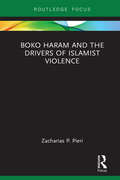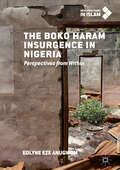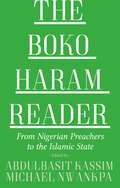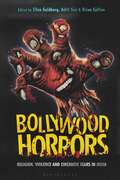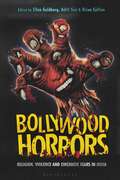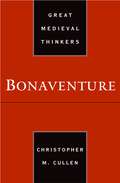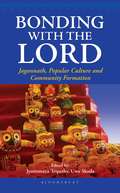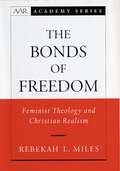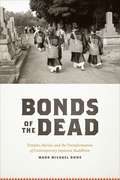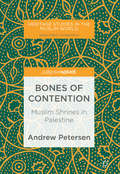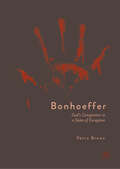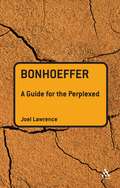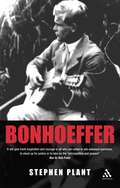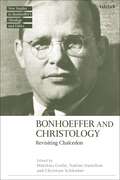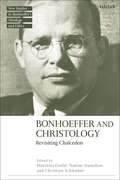- Table View
- List View
Boko Haram and the Drivers of Islamist Violence
by Zacharias P. PieriThis book analyzes the factors that drive Boko Haram’s violence, arguing that the movement is rooted in the historical and religious context of west Africa. The data presented is based on extensive research, including fieldwork in Nigeria, primary source analysis, archival work, and large-scale survey analyses. Each chapter deals with a different case-study that showcases a driver of Boko Haram’s violence, including how the jihad of Usman dan Fodio is used as a source of contemporary inspiration to Boko Haram; how the extrajudicial killing of its then leader Mohammad Yusuf spurred the group to violence; why the kidnapping of the Chibok schoolgirls was motivated by both ideology and strategy; how the formation of a caliphate and pledging of allegiance to ISIS gave Boko Haram an amplified presence; and how the issue of takfir led to the fracturing of the movement. To succeed in the fight against Boko Haram, this book argues, the Nigerian state needs to couple military advances with deep social changes, such as combatting corruption, reforming the police, and investing equitably across the country. This book will be of much interest to students of terrorism and political violence, African politics, war and conflict studies, and security studies in general.
The Boko Haram Insurgence In Nigeria: Perspectives from Within (New Directions in Islam)
by Edlyne Eze AnugwomThis book focuses on the Boko Haram insurgence in Nigeria, and provides information on the origin and growth of the sect, antecedent and historical factors behind the insurgence, assessing a variety of socio-political drivers. The structure, organization and ideology of the sect are analysed, paying attention to internal splits within the group, as well as external relations with the Nigerian state, and global jihadism. The diverse and wide ranging issues covered in the book makes it valuable for academic researchers, students and policy practitioners both within Africa and beyond.
The Boko Haram Reader: From Nigerian Preachers to the Islamic State
by Abdulbasit Kassim and Michael NwankpaSince it erupted onto the world stage in 2009, people have asked, what is Boko Haram, and what does it stand for? Is there a coherent vision or set of beliefs behind it? Despite the growing literature about the group, few if any attempts have been made to answer these questions, even though Boko Haram is but the latest in a long line of millenarian Muslim reform groups to emerge in Northern Nigeria over the last two centuries. The Boko Haram Reader offers an unprecedented collection of essential texts, documents, videos, audio, and nashids (martial hymns), translated into English from Hausa, Arabic and Kanuri, tracing the group's origins, history, and evolution. Its editors, two Nigerian scholars, reveal how Boko Haram's leaders manipulate Islamic theology for the legitimisation, radicalization, indoctrination and dissemination of their ideas across West Africa. Mandatory reading for anyone wishing to grasp the underpinnings of Boko Haram's insurgency, particularly how the group strives to delegitimize its rivals and establish its beliefs as a dominant strand of Islamic thought in West Africa's religious marketplace.
The Boko Haram Reader: From Nigerian Preachers to the Islamic State
Since it erupted onto the world stage in 2009, people have asked, what is Boko Haram, and what does it stand for? Is there a coherent vision or set of beliefs behind it? Despite the growing literature about the group, few if any attempts have been made to answer these questions, even though Boko Haram is but the latest in a long line of millenarian Muslim reform groups to emerge in Northern Nigeria over the last two centuries. The Boko Haram Reader offers an unprecedented collection of essential texts, documents, videos, audio, and nashids (martial hymns), translated into English from Hausa, Arabic and Kanuri, tracing the group's origins, history, and evolution. Its editors, two Nigerian scholars, reveal how Boko Haram's leaders manipulate Islamic theology for the legitimisation, radicalization, indoctrination and dissemination of their ideas across West Africa. Mandatory reading for anyone wishing to grasp the underpinnings of Boko Haram's insurgency, particularly how the group strives to delegitimize its rivals and establish its beliefs as a dominant strand of Islamic thought in West Africa's religious marketplace.
Bollywood Horrors: Religion, Violence and Cinematic Fears in India
by Ellen Goldberg, Aditi Sen, and Brian CollinsBollywood Horrors is a wide-ranging collection that examines the religious aspects of horror imagery, representations of real-life horror in the movies, and the ways in which Hindi films have projected cinematic fears onto the screen. Part one, “Material Cultures and Prehistories of Horror in South Asia” looks at horror movie posters and song booklets and the surprising role of religion in the importation of Gothic tropes into Indian films, told through the little-known story of Sir Devendra Prasad Varma. Part two, “Cinematic Horror, Iconography and Aesthetics” examines the stereotype of the tantric magician found in Indian literature beginning in the medieval period, cinematic representations of the myth of the fearsome goddess Durga's slaying of the Buffalo Demon, and the influence of epic mythology and Hollywood thrillers on the 2002 film Raaz. The final part, “Cultural Horror,” analyzes elements of horror in Indian cinema's depiction of human trafficking, shifting gender roles, the rape-revenge cycle, and communal violence.
Bollywood Horrors: Religion, Violence and Cinematic Fears in India
Bollywood Horrors is a wide-ranging collection that examines the religious aspects of horror imagery, representations of real-life horror in the movies, and the ways in which Hindi films have projected cinematic fears onto the screen. Part one, “Material Cultures and Prehistories of Horror in South Asia” looks at horror movie posters and song booklets and the surprising role of religion in the importation of Gothic tropes into Indian films, told through the little-known story of Sir Devendra Prasad Varma. Part two, “Cinematic Horror, Iconography and Aesthetics” examines the stereotype of the tantric magician found in Indian literature beginning in the medieval period, cinematic representations of the myth of the fearsome goddess Durga's slaying of the Buffalo Demon, and the influence of epic mythology and Hollywood thrillers on the 2002 film Raaz. The final part, “Cultural Horror,” analyzes elements of horror in Indian cinema's depiction of human trafficking, shifting gender roles, the rape-revenge cycle, and communal violence.
Bolton Priory: The Economy Of A Northern Monastery, 1286-1325 (Oxford Historical Monographs)
by Ian KershawThe history of the priory, 1120-1330. The priory's exploitation of its estate. Pasture farming. Investment. Provisions and food consumption at the priory. The priory's finances. The last two centuries.
Bonaventure (Great Medieval Thinkers)
by Christopher M. CullenThe great Franciscan theologian St. Bonaventure (c.1217-74) engaged in philosophy as well as theology, and the relation between the two in Bonaventure's work has long been debated. Yet, few studies have been devoted to Bonaventure's thought as a whole. In this survey, Christopher M. Cullen reveals Bonaventure as a great synthesizer, whose system of thought bridged the gap between theology and philosophy. The book is organized according to the categories of Bonaventure's own classic text, De reductione artium ad theologiam. Cullen follows Bonaventure's own division of the branches of philosophy and theology, analyzing them as separate but related entities. He shows that Bonaventure was a scholastic, whose mysticism was grounded in systematic theological and philosophical reasoning. He presents a fresh and nuanced perspective on Bonaventure's debt to Augustine, while clarifying Aristotle's influence. Cullen also puts Bonaventure's ideas in context of his time and place, contributing significantly to our understanding of the medieval world. This accessible introduction provides a much-needed overview of Bonaventure's thought. Cullen offers a clear and rare reading of "Bonaventurianism" in and for itself, without the complications of critique and comparison. This book promises to become a standard text on Bonaventure, useful for students and scholars of philosophy, theology, medieval studies, and the history of Christianity.
Bonding with the Lord: Jagannath, Popular Culture and Community Formation
by Jyotirmaya Tripathy Uwe SkodaFew other Hindu gods guide a regional consciousness, pervade walks of everyday life and define a collective psyche the way Lord Jagannath does in Odisha and its contiguous areas. Jagannath is metonymic of Odisha and the Odia way of life, arguably much more than any other god for a particular geography or its peoples.While not derecognising the historical and the spiritual aspects of Jagannath, Bonding with the Lord attempts to look at the deployment of Jagannath in contemporary cultural practices involving the sensorium in the widest sense. The project of a cultural Jagannath not only materialises him in people's everyday practices but also democratises scholarship on him. The expansion of the scope of research on Jagannath to cultural expressions in a more encompassing way rather than confining to 'elitist' religious/literary sources makes him an everyday presence and significantly enhances his sphere of influence. Jagannath's 'tribal' origin, his association with Buddhism and Jainism and his avatari status make him an all-encompassing, multilayered symbol and a treasure trove for multiple interpretations.
Bonding with the Lord: Jagannath, Popular Culture and Community Formation
by Jyotirmaya Tripathy Uwe SkodaFew other Hindu gods guide a regional consciousness, pervade walks of everyday life and define a collective psyche the way Lord Jagannath does in Odisha and its contiguous areas. Jagannath is metonymic of Odisha and the Odia way of life, arguably much more than any other god for a particular geography or its peoples.While not derecognising the historical and the spiritual aspects of Jagannath, Bonding with the Lord attempts to look at the deployment of Jagannath in contemporary cultural practices involving the sensorium in the widest sense. The project of a cultural Jagannath not only materialises him in people's everyday practices but also democratises scholarship on him. The expansion of the scope of research on Jagannath to cultural expressions in a more encompassing way rather than confining to 'elitist' religious/literary sources makes him an everyday presence and significantly enhances his sphere of influence. Jagannath's 'tribal' origin, his association with Buddhism and Jainism and his avatari status make him an all-encompassing, multilayered symbol and a treasure trove for multiple interpretations.
The Bonds of Freedom: Feminist Theology and Christian Realism (AAR Academy Series)
by Rebekah L. MilesIn this constructive study, Miles proposes a new feminist theological ethic, drawing together the contributions of Reinhold Niebuhr, Sharon Welch, and Rosemary Ruether. Seeking to critically reappropriate the Christian realism articulated by Niebuhr, she reinterprets solutions to problems emergent from his theology. Miles presents feminist Christian realism as an alternative that can reclaim a positive interpretation of divine transcendence and human self-transcendence, while maintaining newer emphases on human boundedness and divine immanence. Theologians and ethicists will find her critical reassessment of the three authors distinctive and her challenging proposal for a "positive creative transformation" a significant contribution to the development of feminist ethics.
Bonds of the Dead: Temples, Burial, and the Transformation of Contemporary Japanese Buddhism (Buddhism and Modernity)
by Mark Michael RoweDespite popular images of priests seeking enlightenment in snow-covered mountain temples, the central concern of Japanese Buddhism is death. For that reason, Japanese Buddhism’s social and economic base has long been in mortuary services—a base now threatened by public debate over the status, treatment, and location of the dead. Bonds of the Dead explores the crisis brought on by this debate and investigates what changing burial forms reveal about the ways temple Buddhism is perceived and propagated in contemporary Japan. Mark Rowe offers a crucial account of how religious, political, social, and economic forces in the twentieth century led to the emergence of new funerary practices in Japan and how, as a result, the care of the dead has become the most fundamental challenge to the continued existence of Japanese temple Buddhism. Far from marking the death of Buddhism in Japan, Rowe argues, funerary Buddhism reveals the tradition at its most vibrant. Combining ethnographic research with doctrinal considerations, this is a fascinating book for anyone interested in Japanese society and religion.
Bonds of the Dead: Temples, Burial, and the Transformation of Contemporary Japanese Buddhism (Buddhism and Modernity)
by Mark Michael RoweDespite popular images of priests seeking enlightenment in snow-covered mountain temples, the central concern of Japanese Buddhism is death. For that reason, Japanese Buddhism’s social and economic base has long been in mortuary services—a base now threatened by public debate over the status, treatment, and location of the dead. Bonds of the Dead explores the crisis brought on by this debate and investigates what changing burial forms reveal about the ways temple Buddhism is perceived and propagated in contemporary Japan. Mark Rowe offers a crucial account of how religious, political, social, and economic forces in the twentieth century led to the emergence of new funerary practices in Japan and how, as a result, the care of the dead has become the most fundamental challenge to the continued existence of Japanese temple Buddhism. Far from marking the death of Buddhism in Japan, Rowe argues, funerary Buddhism reveals the tradition at its most vibrant. Combining ethnographic research with doctrinal considerations, this is a fascinating book for anyone interested in Japanese society and religion.
Bonds of the Dead: Temples, Burial, and the Transformation of Contemporary Japanese Buddhism (Buddhism and Modernity)
by Mark Michael RoweDespite popular images of priests seeking enlightenment in snow-covered mountain temples, the central concern of Japanese Buddhism is death. For that reason, Japanese Buddhism’s social and economic base has long been in mortuary services—a base now threatened by public debate over the status, treatment, and location of the dead. Bonds of the Dead explores the crisis brought on by this debate and investigates what changing burial forms reveal about the ways temple Buddhism is perceived and propagated in contemporary Japan. Mark Rowe offers a crucial account of how religious, political, social, and economic forces in the twentieth century led to the emergence of new funerary practices in Japan and how, as a result, the care of the dead has become the most fundamental challenge to the continued existence of Japanese temple Buddhism. Far from marking the death of Buddhism in Japan, Rowe argues, funerary Buddhism reveals the tradition at its most vibrant. Combining ethnographic research with doctrinal considerations, this is a fascinating book for anyone interested in Japanese society and religion.
Bonds of the Dead: Temples, Burial, and the Transformation of Contemporary Japanese Buddhism (Buddhism and Modernity)
by Mark Michael RoweDespite popular images of priests seeking enlightenment in snow-covered mountain temples, the central concern of Japanese Buddhism is death. For that reason, Japanese Buddhism’s social and economic base has long been in mortuary services—a base now threatened by public debate over the status, treatment, and location of the dead. Bonds of the Dead explores the crisis brought on by this debate and investigates what changing burial forms reveal about the ways temple Buddhism is perceived and propagated in contemporary Japan. Mark Rowe offers a crucial account of how religious, political, social, and economic forces in the twentieth century led to the emergence of new funerary practices in Japan and how, as a result, the care of the dead has become the most fundamental challenge to the continued existence of Japanese temple Buddhism. Far from marking the death of Buddhism in Japan, Rowe argues, funerary Buddhism reveals the tradition at its most vibrant. Combining ethnographic research with doctrinal considerations, this is a fascinating book for anyone interested in Japanese society and religion.
Bonds of the Dead: Temples, Burial, and the Transformation of Contemporary Japanese Buddhism (Buddhism and Modernity)
by Mark Michael RoweDespite popular images of priests seeking enlightenment in snow-covered mountain temples, the central concern of Japanese Buddhism is death. For that reason, Japanese Buddhism’s social and economic base has long been in mortuary services—a base now threatened by public debate over the status, treatment, and location of the dead. Bonds of the Dead explores the crisis brought on by this debate and investigates what changing burial forms reveal about the ways temple Buddhism is perceived and propagated in contemporary Japan. Mark Rowe offers a crucial account of how religious, political, social, and economic forces in the twentieth century led to the emergence of new funerary practices in Japan and how, as a result, the care of the dead has become the most fundamental challenge to the continued existence of Japanese temple Buddhism. Far from marking the death of Buddhism in Japan, Rowe argues, funerary Buddhism reveals the tradition at its most vibrant. Combining ethnographic research with doctrinal considerations, this is a fascinating book for anyone interested in Japanese society and religion.
Bonds of the Dead: Temples, Burial, and the Transformation of Contemporary Japanese Buddhism (Buddhism and Modernity)
by Mark Michael RoweDespite popular images of priests seeking enlightenment in snow-covered mountain temples, the central concern of Japanese Buddhism is death. For that reason, Japanese Buddhism’s social and economic base has long been in mortuary services—a base now threatened by public debate over the status, treatment, and location of the dead. Bonds of the Dead explores the crisis brought on by this debate and investigates what changing burial forms reveal about the ways temple Buddhism is perceived and propagated in contemporary Japan. Mark Rowe offers a crucial account of how religious, political, social, and economic forces in the twentieth century led to the emergence of new funerary practices in Japan and how, as a result, the care of the dead has become the most fundamental challenge to the continued existence of Japanese temple Buddhism. Far from marking the death of Buddhism in Japan, Rowe argues, funerary Buddhism reveals the tradition at its most vibrant. Combining ethnographic research with doctrinal considerations, this is a fascinating book for anyone interested in Japanese society and religion.
Bone Black: Memories of Girlhood
by bell hooksOne of bell hooks' foundational works introduced to the UK for the first time.'With the emotion of poetry, the narrative of a novel, and the truth of experience, bell hooks weaves a girlhood memoir you won't be able to put down―or forget. Bone Black takes us into the cave of self-creation' Gloria SteinemStitching together the threads of her girlhood memories, bell hooks shows us one strong-spirited child's journey toward becoming the pioneering writer we know. Along the way, hooks sheds light on the vulnerability of children, the special unfurling of female creativity and the imbalance of a society that confers marriage's joys upon men and its silences on women.In a world where daughters and fathers are strangers under the same roof, and crying children are often given something to cry about, hooks uncovers the solace to be found in solitude, the comfort to be had in the good company of books.Bone Black allows us to bear witness to the awakening of a legendary author's awareness that writing is her most vital breath.
Bones of Contention: Muslim Shrines in Palestine
by Andrew PetersenThis pivot sets Muslim shrines within the wider context of Heritage Studies in the Muslim world and considers their role in the articulation of sacred landscapes, their function as sites of cultural memory and their links to different religious traditions. Reviewing the historiography of Muslim shrines paying attention to the different ways these places have been studied, through anthropology, archaeology, history, and religious studies, the text discusses the historical and archaeological evidence for the development of shrines in the region from pre-Islamic times up to the present day. It also assesses the significance of Muslim shrines in the modern Middle East, focusing on the diverse range of opinions and treatments from veneration to destruction, and argues that shrines have a unique social function as a means of direct contact with the past in a region where changing political configurations have often distorted conventional historical narratives.
Bones of Contention: Muslim Shrines in Palestine
by Andrew PetersenThis pivot sets Muslim shrines within the wider context of Heritage Studies in the Muslim world and considers their role in the articulation of sacred landscapes, their function as sites of cultural memory and their links to different religious traditions. Reviewing the historiography of Muslim shrines paying attention to the different ways these places have been studied, through anthropology, archaeology, history, and religious studies, the text discusses the historical and archaeological evidence for the development of shrines in the region from pre-Islamic times up to the present day. It also assesses the significance of Muslim shrines in the modern Middle East, focusing on the diverse range of opinions and treatments from veneration to destruction, and argues that shrines have a unique social function as a means of direct contact with the past in a region where changing political configurations have often distorted conventional historical narratives.
Bonhoeffer: God’s Conspirator in a State of Exception
by Petra BrownTheologian. Conspirator. Martyr. Saint. Dietrich Bonhoeffer was killed in the waning days of World War II, having been implicated in the July 20th assassination attempt on Hitler. Since his death, Bonhoeffer’s life and writings have inspired contradictory responses. He is often seen as a model for Christian pacifist resistance, and more recently for violent direct political action. Bonhoeffer’s name has been invoked by violent anti-abortion protestors as well as political leaders calling for support on a ‘war on terror’ in the aftermath of 9/11. Petra Brown critically analyses Bonhoeffer’s writing preceding and during his conspiracy involvement, particularly his recurring concept of the ‘extraordinary.’ Brown examines this idea in light of ‘the state of exception,’ a concept coined by the one-time Nazi jurist and political theorist, Carl Schmitt. She also draws on the existentialist philosopher Sören Kierkegaard to consider what happens when discipleship is understood as obedience to a divine command. This book aims to complicate an unreflective admiration of Bonhoeffer’s decision for conspiracy, and draws attention to the potentially dangerous implications of his emerging political theology.
Bonhoeffer: A Guide For The Perplexed (Guides for the Perplexed #207)
by Joel LawrenceJoel Lawrence offers a new methodology and a fresh perspective in this book, making it a concise guide to one of the most remarkable martyrs and theologians of the 20th century.
Bonhoeffer (Outstanding Christian Thinkers)
by Stephen PlantOne of the best known Christians of the twentieth century, Dietrich Bonhoeffer is admired as a theologian for his unparalleled independence of mind, creativity and brilliance by liberals and conservatives alike. His death at the hands of the Nazis is an extraordinary tale of courage and Christian discipleship. However, Bonhoeffer was also a serious theologian who, while indebted to the liberal tradition of the University of Berlin, was also influenced by the new thinking of Karl Barth that challenged the consensus. Plant has written a critical exploration of Bonhoeffer's writings that illuminates his ethical theology, showing that what linked all his work was the attempt to listen to God's word in, to, and for the secular world.
Bonhoeffer and Christology: Revisiting Chalcedon (T&T Clark New Studies in Bonhoeffer’s Theology and Ethics)
by Matthias Grebe, Nadine Hamilton and Christian SchlenkerThe key question this volume addresses is 'how does Bonhoeffer's thought help to re(dis)cover the doctrine of Christ's two natures and one person and understand and renew it in its significance for a modern post-metaphysical and secular world?' The volume takes a fresh look at Dietrich Bonhoeffer's Christology and brings it into a fruitful dialogue with current Christological debates. In a multi-perspectival, pluralistic world, Bonhoeffer's thinking offers a productive basis for conceptually incorporating the openness required for this task into academic theology. Bonhoeffer's theology offers a starting point for the recovery of a productive Christology that reflects the plurality of the globalized world, as Bonhoeffer's Christology begins precisely with this integration into worldly reality, whereby the world is understood in its plurality and polyphony. In this way, he characterizes his enterprise as follows: “What keeps gnawing at me is the question, what is Christianity, or who is Christ actually for us today” (DBWE 8, 362). Accordingly, it opens itself up not only to inner-Christian discussion but also to non-Christian worldviews, from which a basic ethical demand follows.
Bonhoeffer and Christology: Revisiting Chalcedon (T&T Clark New Studies in Bonhoeffer’s Theology and Ethics)
The key question this volume addresses is 'how does Bonhoeffer's thought help to re(dis)cover the doctrine of Christ's two natures and one person and understand and renew it in its significance for a modern post-metaphysical and secular world?' The volume takes a fresh look at Dietrich Bonhoeffer's Christology and brings it into a fruitful dialogue with current Christological debates. In a multi-perspectival, pluralistic world, Bonhoeffer's thinking offers a productive basis for conceptually incorporating the openness required for this task into academic theology. Bonhoeffer's theology offers a starting point for the recovery of a productive Christology that reflects the plurality of the globalized world, as Bonhoeffer's Christology begins precisely with this integration into worldly reality, whereby the world is understood in its plurality and polyphony. In this way, he characterizes his enterprise as follows: “What keeps gnawing at me is the question, what is Christianity, or who is Christ actually for us today” (DBWE 8, 362). Accordingly, it opens itself up not only to inner-Christian discussion but also to non-Christian worldviews, from which a basic ethical demand follows.
